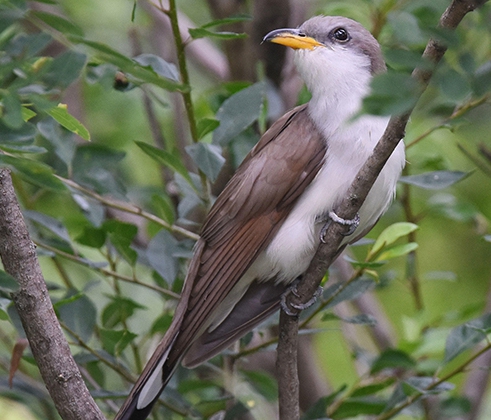Western Yellow-billed Cuckoo
In 2014, the western Yellow-billed Cuckoo (YBCU) was federally listed as threatened by the U.S. Fish and Wildlife Service.
-
Scientific Name: Coccyzus americanus
-
Species Abbreviation: YBCU
-
Status:
Federally Threatened Species;
New Mexico Species of Greatest Conservation Need
- Documents
-
View documents from the Program Library.
See All documents

Photo Credit: Andy Reago and Chrissy McClarren
- National Park Service Western Yellow-billed Cuckoo
- U.S. Fish and Wildlife Service Environmental Conservation Online System
- U.S. Fish and Wildlife Service Yellow-billed Cuckoo
- U.S. Fish and Wildlife Service Designation of Critical Habitat for the Western Distinct Population Segment of the Yellow-billed Cuckoo
- U.S. Fish and Wildlife Service Yellow-billed Cuckoo 5-Year Review
- Biota Information System of New Mexico (BISON-M)
- New Mexico Avian Conservation Partners
Description
The Yellow-billed Cuckoo is a fairly large, slim, long-tailed bird, which is sometimes confused with a dove. The species is about 12 inches long and weighs about 60 grams. The upper part of its long tail is greyish brown and the lower part is marked with six white spots against a black background. The YBCU's thick, downcurved bill is mostly yellow and almost as long as its head. The bird's head and back are a warm brown color, which contrasts with its clean whitish underparts. The YBCU's darker face mask is paired with a yellow eye ring. Key markers to look for when identifying the species are the six white spots on its tail and the large reddish-brown patches on its wings, which are visible in flight. YBCU males, females, and juveniles have similar plumage, although the males have a more distinct pattern of white spots. Although most songbirds have a three-forward and one backward pointing toe arrangement, the YBCU has zygodactyl feet (two toes forward and two toes backward). This bird is often hidden within dense foliage, but it can be detected by its loud Kowlp call that sounds like ka ka k aka ka kow kow kow kowlpkowlp.
In the western U.S. and Mexico, the western YBCU breeds in low- to moderate-elevation native forests generally characterized by a dense understory of native woody riparian or xeroriparian shrubs, a dense mid- to upper level canopy with at least a few native canopy trees, and a robust groundcover of forbs that support its preferred prey. It requires relatively large (>20 hectares) patches of riparian habitat with multilayered canopies for nesting and foraging. The migration and wintering habitat needs of the western YBCU are not well known, but there is on-going research on this topic. The western YBCU typically arrives on breeding grounds in early to mid-June. During the breeding season, it is loosely territorial, tending to use larger areas rather than strictly defending nesting territories. The breeding cycle proceeds quickly and can last only 17 days from egg-laying to fledging. The females lay 1-5 eggs, which hatch in 9-11 days. Nestlings begin to fledge at 6-9 days old. The western YBCU's diet consists of caterpillars, cicadas, katydids, other large insects, frogs, and lizards. It also will eat fruit and seeds, particularly during the nonbreeding season.
Distribution
The Yellow-billed Cuckoo is a Neotropical landbird that breeds in North America south to Mexico and the Greater Antilles, migrates through Central America, and spends the austral summer in South America, east of the Andes. The eastern and western populations are geographically separated by high mountains, extensive deserts, and areas of unsuitable habitats. The western breeding population was designated by the U.S. Fish and Wildlife Service in 2014 as a Distinct Population Segment (DPS) with its eastern boundary being defined as the Continental Divide from Montana to central Colorado, the eastern edge of the Rio Grande drainage from central Colorado to Texas, the mountain ranges that form a southeastern extension of the Rocky Mountains to the Big Bend area in west Texas, and portions of the Chihuahuan Desert in Mexico. The historical breeding range of the western DPS in the U.S. included Arizona, California, Colorado, Idaho, Montana, Nevada, New Mexico, Oregon, west Texas, Utah, Washington, and Wyoming. Currently, the largest breeding populations in the western U.S. are found in Arizona and New Mexico, with smaller populations found in California and a rare few found along rivers in Idaho, Utah, and Colorado.
Recovery Efforts
Due to extensive loss, degradation, and fragmentation of its required habitats likely both on the breeding grounds and across its full annual range, Yellow-billed Cuckoo breeding populations have declined across North America and have been extirpated or have undergone catastrophic declines in western Canada and across most of the Western U.S. The western YBCU's range has contracted southward and eastward. It has disappeared entirely from British Columbia and the Pacific Northwest. In California, the number of pairs was found to be only 30-33 in 1986-1987, compared to the estimated 15,000 pairs in the late nineteenth century. Surveys in Arizona also indicated that less than 200 pairs remained in the state by 1986. In 2014, the U.S. Fish and Wildlife Service listed the western YBCU DPS as threatened under the federal Endangered Species Act.
In 2020, the MRGESCP included recovery of the western YBCU in its long-term goals. Signatories of the MRGESCP have conducted studies, monitoring, surveys, and habitat restoration to benefit the western YBCU.
